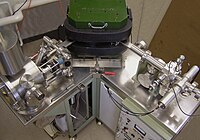
Photo from wikipedia
Abstract The traceability of food products in terms of their geographical origins is getting more and more public attention. To be certain of the origin of organically grown potato (Solanum… Click to show full abstract
Abstract The traceability of food products in terms of their geographical origins is getting more and more public attention. To be certain of the origin of organically grown potato (Solanum tuberosum L.), samples were subjected to stable isotope analysis of the major bioelements (δ13C, δ15N, δ18O, δ34S) and to element profiling (Na, Mg, P, S, Cl, K, Ca, Mn, Fe, Ni, Cu, Zn, Mo, Br, Rb, Sr), which included the rare earth elements (Sc, Y, Nb, La, Ce, Pr, Nd, Dy, Er). The present study was performed at the scale of Slovenia, which has diverse geographical characteristics. Using supervised pattern recognition statistical analysis (i.e., multivariate discriminant analysis), the characterisation and classification of organically grown potatoes were defined in terms of four Slovenian macro-regions: the Alpine, Dinaric, Mediterranean and Pannonian regions. The proposed model showed that 100% of the samples were correctly classified. However, an important prerequisite for official monitoring of the origin of a commodity is the availability of national and/or international databanks. As no databank exists for potato to date, the present study was performed to initiate the collection of data at the national level, to build a relevant and up-to-date databank. Once established, a reliable traceability model can be created.
Journal Title: Journal of Food Composition and Analysis
Year Published: 2018
Link to full text (if available)
Share on Social Media: Sign Up to like & get
recommendations!